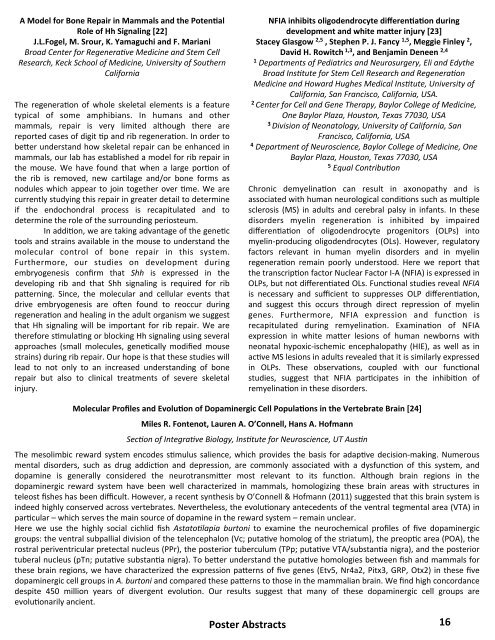Program - The Institute for Neuroscience - The University of Texas at ...
Program - The Institute for Neuroscience - The University of Texas at ...
Program - The Institute for Neuroscience - The University of Texas at ...
Create successful ePaper yourself
Turn your PDF publications into a flip-book with our unique Google optimized e-Paper software.
A Model <strong>for</strong> Bone Repair in Mammals and the PotenYal<br />
Role <strong>of</strong> Hh Signaling [22]<br />
J.L.Fogel, M. Srour, K. Yamaguchi and F. Mariani<br />
Broad Center <strong>for</strong> Regenera5ve Medicine and Stem Cell<br />
Research, Keck School <strong>of</strong> Medicine, <strong>University</strong> <strong>of</strong> Southern<br />
Cali<strong>for</strong>nia<br />
<strong>The</strong> regenera8on <strong>of</strong> whole skeletal elements is a fe<strong>at</strong>ure<br />
typical <strong>of</strong> some amphibians. In humans and other<br />
mammals, repair is very limited although there are<br />
reported cases <strong>of</strong> digit 8p and rib regenera8on. In order to<br />
beEer understand how skeletal repair can be enhanced in<br />
mammals, our lab has established a model <strong>for</strong> rib repair in<br />
the mouse. We have found th<strong>at</strong> when a large por8on <strong>of</strong><br />
the rib is removed, new car8lage and/or bone <strong>for</strong>ms as<br />
nodules which appear to join together over 8me. We are<br />
currently studying this repair in gre<strong>at</strong>er detail to determine<br />
if the endochondral process is recapitul<strong>at</strong>ed and to<br />
determine the role <strong>of</strong> the surrounding periosteum.<br />
In addi8on, we are taking advantage <strong>of</strong> the gene8c<br />
tools and strains available in the mouse to understand the<br />
molecular control <strong>of</strong> bone repair in this system.<br />
Furthermore, our studies on development during<br />
embryogenesis confirm th<strong>at</strong> Shh is expressed in the<br />
developing rib and th<strong>at</strong> Shh signaling is required <strong>for</strong> rib<br />
paEerning. Since, the molecular and cellular events th<strong>at</strong><br />
drive embryogenesis are oBen found to reoccur during<br />
regenera8on and healing in the adult organism we suggest<br />
th<strong>at</strong> Hh signaling will be important <strong>for</strong> rib repair. We are<br />
there<strong>for</strong>e s8mula8ng or blocking Hh signaling using several<br />
approaches (small molecules, gene8cally modified mouse<br />
strains) during rib repair. Our hope is th<strong>at</strong> these studies will<br />
lead to not only to an increased understanding <strong>of</strong> bone<br />
repair but also to clinical tre<strong>at</strong>ments <strong>of</strong> severe skeletal<br />
injury.<br />
NFIA inhibits oligodendrocyte differenYaYon during<br />
development and white macer injury [23]<br />
Stacey Glasgow 2,5 , Stephen P. J. Fancy 1,5 , Meggie Finley 2 ,<br />
David H. Rowitch 1,3 , and Benjamin Deneen 2,4<br />
1 Departments <strong>of</strong> Pedi<strong>at</strong>rics and Neurosurgery, Eli and Edythe<br />
Broad Ins5tute <strong>for</strong> Stem Cell Research and Regenera5on<br />
Medicine and Howard Hughes Medical Ins5tute, <strong>University</strong> <strong>of</strong><br />
Cali<strong>for</strong>nia, San Francisco, Cali<strong>for</strong>nia, USA.<br />
2 Center <strong>for</strong> Cell and Gene <strong>The</strong>rapy, Baylor College <strong>of</strong> Medicine,<br />
One Baylor Plaza, Houston, <strong>Texas</strong> 77030, USA<br />
3 Division <strong>of</strong> Neon<strong>at</strong>ology, <strong>University</strong> <strong>of</strong> Cali<strong>for</strong>nia, San<br />
Francisco, Cali<strong>for</strong>nia, USA<br />
4 Department <strong>of</strong> <strong>Neuroscience</strong>, Baylor College <strong>of</strong> Medicine, One<br />
Baylor Plaza, Houston, <strong>Texas</strong> 77030, USA<br />
5 Equal Contribu5on<br />
Chronic demyelina8on can result in axonop<strong>at</strong>hy and is<br />
associ<strong>at</strong>ed with human neurological condi8ons such as mul8ple<br />
sclerosis (MS) in adults and cerebral palsy in infants. In these<br />
disorders myelin regenera8on is inhibited by impaired<br />
differen8a8on <strong>of</strong> oligodendrocyte progenitors (OLPs) into<br />
myelin-‐producing oligodendrocytes (OLs). However, regul<strong>at</strong>ory<br />
factors relevant in human myelin disorders and in myelin<br />
regenera8on remain poorly understood. Here we report th<strong>at</strong><br />
the transcrip8on factor Nuclear Factor I-‐A (NFIA) is expressed in<br />
OLPs, but not differen8<strong>at</strong>ed OLs. Func8onal studies reveal NFIA<br />
is necessary and sufficient to suppresses OLP differen8a8on,<br />
and suggest this occurs through direct repression <strong>of</strong> myelin<br />
genes. Furthermore, NFIA expression and func8on is<br />
recapitul<strong>at</strong>ed during remyelina8on. Examina8on <strong>of</strong> NFIA<br />
expression in white maEer lesions <strong>of</strong> human newborns with<br />
neon<strong>at</strong>al hypoxic-‐ischemic encephalop<strong>at</strong>hy (HIE), as well as in<br />
ac8ve MS lesions in adults revealed th<strong>at</strong> it is similarly expressed<br />
in OLPs. <strong>The</strong>se observa8ons, coupled with our func8onal<br />
studies, suggest th<strong>at</strong> NFIA par8cip<strong>at</strong>es in the inhibi8on <strong>of</strong><br />
remyelina8on in these disorders.<br />
Molecular Pr<strong>of</strong>iles and EvoluYon <strong>of</strong> Dopaminergic Cell PopulaYons in the Vertebr<strong>at</strong>e Brain [24]<br />
Miles R. Fontenot, Lauren A. O’Connell, Hans A. H<strong>of</strong>mann<br />
Sec5on <strong>of</strong> Integra5ve Biology, Ins5tute <strong>for</strong> <strong>Neuroscience</strong>, UT Aus5n<br />
<strong>The</strong> mesolimbic reward system encodes s8mulus salience, which provides the basis <strong>for</strong> adap8ve decision-‐making. Numerous<br />
mental disorders, such as drug addic8on and depression, are commonly associ<strong>at</strong>ed with a dysfunc8on <strong>of</strong> this system, and<br />
dopamine is generally considered the neurotransmiEer most relevant to its func8on. Although brain regions in the<br />
dopaminergic reward system have been well characterized in mammals, homologizing these brain areas with structures in<br />
teleost fishes has been difficult. However, a recent synthesis by O’Connell & H<strong>of</strong>mann (2011) suggested th<strong>at</strong> this brain system is<br />
indeed highly conserved across vertebr<strong>at</strong>es. Nevertheless, the evolu8onary antecedents <strong>of</strong> the ventral tegmental area (VTA) in<br />
par8cular – which serves the main source <strong>of</strong> dopamine in the reward system – remain unclear.<br />
Here we use the highly social cichlid fish Ast<strong>at</strong>o5lapia burtoni to examine the neurochemical pr<strong>of</strong>iles <strong>of</strong> five dopaminergic<br />
groups: the ventral subpallial division <strong>of</strong> the telencephalon (Vc; puta8ve homolog <strong>of</strong> the stri<strong>at</strong>um), the preop8c area (POA), the<br />
rostral periventricular pretectal nucleus (PPr), the posterior tuberculum (TPp; puta8ve VTA/substan8a nigra), and the posterior<br />
tuberal nucleus (pTn; puta8ve substan8a nigra). To beEer understand the puta8ve homologies between fish and mammals <strong>for</strong><br />
these brain regions, we have characterized the expression paEerns <strong>of</strong> five genes (Etv5, Nr4a2, Pitx3, GRP, Otx2) in these five<br />
dopaminergic cell groups in A. burtoni and compared these paEerns to those in the mammalian brain. We find high concordance<br />
despite 450 million years <strong>of</strong> divergent evolu8on. Our results suggest th<strong>at</strong> many <strong>of</strong> these dopaminergic cell groups are<br />
evolu8onarily ancient.<br />
Poster Abstracts<br />
16


